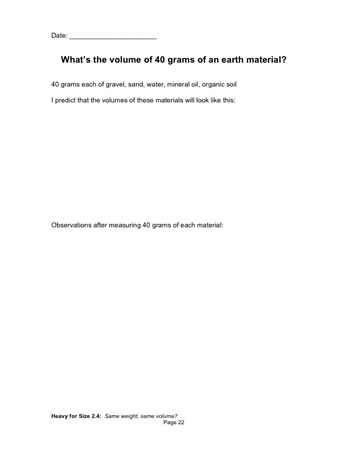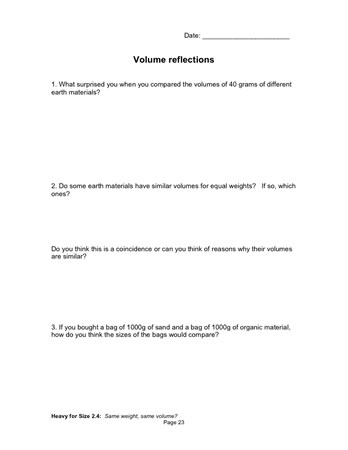Same weight, same volume?
Plan Investigation 2.4
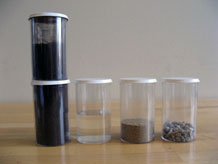
By now students are aware that materials having the same volume can have different weights. But do they understand that the reverse must also be true? In this investigation they confirm that materials having the same weight can have different volumes.
Students review the weight data for the materials they have studied so far — sand, water, mineral, and organic soil. Then they predict how the volumes of these materials will compare if the weights are held constant. They also consider a new material: gravel. They check their predictions by measuring out equal weights of the materials and comparing the volumes.
By the end of the investigation, students will have a clearer understanding that weight and volume are different properties of earth materials. They will also have a deeper understanding of what it means to say that a material is "heavy [or light] for its size."
Learning Goals
- See whether equal weights of different materials have the same volume
- Distinguish weight and volume
| Sequence of experiences | ||
|---|---|---|
| 1. Ask the question | All Class | 10 Mins |
| 2. Predict volumes | Small Groups | 10 Mins |
| 3. Test predictions | Small Groups | 15 Mins |
| 4. Discuss the results | Discussion | 10 Mins |
Materials and Preparation
For the class:
- Post the investigation question in a place where all students can see it.
- Post the investigation question for Investigation 2.1., i.e., “Same volume, same weight?”
- 4 classroom weighing stations:
-
- 1 water weighing station:
- 1 pitcher of water
- 2 pipettes
- 1 digital scale
- 1 gravel weighing station:
- 1 container of gravel
- 2 spoons
- 1 digital scale
- 1 organic soil weighing station:
- 1 container of organic soil
- 2 spoons
- 1 digital scale
- 1 sand weighing station:
- 1 container of sand
- 2 spoons
- 1 digital scale
- 1 water weighing station:
For each tray:
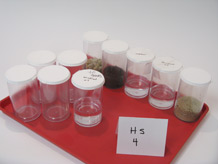
- 1 capped 150cc container with exactly 40cc of fresh water (from the last investigation)*
- 1 capped 150cc container with exactly 40cc of mineral oil (from the last investigation)*
- 1 capped 150cc container with 40cc of sand (from the last investigation)*
- 1 capped 150cc container with 40cc of organic soil (from the last investigation)*
- 1 capped 150cc container with 40cc of gravel*
- 1 capped 150cc container with exactly 40 grams (not 40cc) of mineral oil **
- 4 capped 150cc containers, empty
** The mineral oil containers are used again in Investigation 3.3.
1. Ask the question
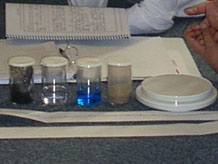
Introduce the investigation question:
Same weight, same volume?
Wait — that question seems very familiar. Hasn't the class already done this investigation? No, not exactly. Draw attention to the investigation question for the first session of this unit:
Same volume, same weight?
Is this the same question? How is it different? Can the class guess what today's investigation will be?
Ask a volunteer to summarize the investigation the class has already done weighing samples of earth materials that have the same volume. As a reminder, show one set of the containers holding equal volumes of sand, organic soil, water, and mineral oil.
- What did we discover?
- When volumes are the same, different materials can have different weights.
- Some materials are heavier for their size than others
Explain that today the class will explore the opposite question.
- When weights are the same, how do the volumes compare?
- How might we go about finding out?
Listen carefully to the answers. Make sure students are clear on the difference between weight and volume, that they can imagine how to turn the previous experiment around, and that their preliminary thinking is on track.
2. Predict volumes

Distribute a tray of materials to each group, but hold back the empty containers and the second container of mineral oil (the one containing 40 grams of oil) for now. Draw attention to the new material — the gravel — and point out that all the materials take up the same amount of space. Check for understanding:
- Do these materials have the same weight or the same volume?
- the same volume
Students will fill containers with equal weights (40 grams) of these same materials. Then they will see how the volumes compare. But first you want them to predict what the results will be, and how the materials will line up in volume order.
- How do you think the volumes will compare when every container has 40 grams of material?
- What will the order be, from least volume to most volume?
Ask students to take five minutes to record their thoughts and predictions in their science notebooks [What is the volume of 40 grams of an earth material?]. If they are stumped, suggest that they go back to their weight data recorded earlier in their notebooks.
You may need to remind students that they are working with the bulk volumes of the granular materials. The volume will include the air between the grains of sand, organic soil, and gravel.
What is bulk volume? Bulk volume is a term used to define the amount of space taken up by a granular solid like soil. In these materials, there are actually three volumes: the volume of the grains; the volume of the spaces between the grains; and the total volume, or bulk volume, which is the sum of both. Bulk volume can change. For example, when soil is compressed, the volume of air is reduced.
3. Test predictions
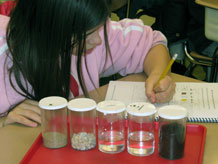
Distribute four empty containers and a container holding 40g of mineral oil to each group. Then have the students test their predictions by filling the containers with a measured amount — 40 grams — of each of the other four earth materials (sand, water, organic soil, and gravel), which they will find at the weighing stations. Students may divide up the work.
As you circulate among the groups, check that they remember to allow for the weight of the empty container and its lid (approx. 26g). The total weight of the sample should be 40 grams plus the weight of the container.
Provide time for students to record their observations in their notebooks using labeled drawings [What is the volume of 40 grams of an earth material?].
Too much soil? Forty grams of organic soil may not fit into one container. Have additional empty containers available for students to use if they need them.
Once the containers have 40g of material, students can tap them a few times to settle the contents, but they should not compress the materials directly by pushing down on them. They should then place the materials in volume order, from least volume to most volume.
4. Discuss the results
Purpose of the Discussion
The purpose of the discussion is for students to use data to answer the investigation question, Same weight, same volume?. They make claims and describe their supporting evidence. Their discussion helps them to solidify the difference between weight and volume and to recognize that some materials are heavier for their size than others.
Engage Students in the Focus Question
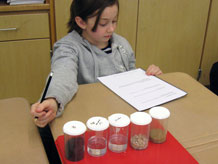
All five containers weighed 40 grams. Were their volumes the same? How did they compare?
Have the groups share their results. Do all groups agree on the order of the materials? When there is consensus, write the order on the board or post a sketch of the five labeled containers, arranged from least to most.
The order is: sand or gravel, water, mineral oil, organic material. The sand and gravel are very close in volume; groups may differ on which material takes up more space.
Do the results match the students' predictions? Are there any surprises?
Did students expect gravel and sand to be similar? Did anyone think the gravel might take up more space because the spaces between the pieces are so big?
Summarize the Discussion
Reinforce the idea of heavy for size by asking some probing questions:
- Would the order change if we had just 5g of each material? What if we have 500g of each material? Why not?
- Do any of these earth materials have similar volumes for equal weights?
- yes, gravel and sand
- Do you think this is a coincidence, or might there be a reason why sand and gravel are similar?
- Sand and gravel have different grain sizes but the minerals of which they are made are very similar.
Allow time for students to write responses to the reflection questions in their notebooks [Volume reflections].
Recap the Section
Wrap up this section of the curriculum by returning to the investigation questions that began and ended this unit:
Same weight, same volume?
Same volume, same weight?
Students have seen, with their own eyes, that materials that have the same weight can have different volumes — just as materials that have the same volume can have different weights.
Check that students are taking away the important points of this unit:
- Weight and volume are not the same thing.
- Weight and volume are different properties of a sample of earth materials.
- Some earth materials are heavy for their size, while others are relatively light for their size.
- Earth materials that are heavy for their size take up less space than materials that are light for their size, for an equal weight.
Cleanup: When finished, students may return the 40g samples of water, gravel, sand, and organic material to their original containers. All the 40cc samples and the 40g container of mineral oil should be saved.


